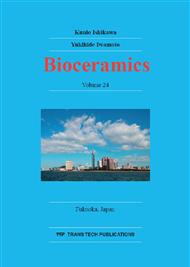[1]
K. Whang, K.E. Healy, D.R. Elenz, E.K. Nam, D.C. Tsai, C.H. Thomas, G.W. Nuber, F.H. Glorieux, R. Travers, S.M. Sprague, Engineering Bone Regeneration with Bioabsorbable Scaffolds with Novel Microarchitecture, Tissue Engineering. 5 (1999) 35-51.
DOI: 10.1089/ten.1999.5.35
Google Scholar
[2]
M.V. Cabañas, J. Peña, J. Román, M. Vallet-Regí, Tailoring vancomycin release from β-TCP/agarose scaffolds, European Journal of Pharmaceutical Sciences. 37 (2009) 249-256.
DOI: 10.1016/j.ejps.2009.02.011
Google Scholar
[3]
S. Kimakhe, S. Bohic, C. Larrose, A. Reynaud, P. Pilet, B. Giumelli, D. Heymann, G. Daculsi, Biological activities of sustained polymyxin B release from calcium phosphate biomaterial prepared by dynamic compaction: An in vitro study, Journal of Biomedical Materials Research. 47 (1999).
DOI: 10.1002/(sici)1097-4636(199910)47:1<18::aid-jbm3>3.0.co;2-t
Google Scholar
[4]
C. Castro, C. Évora, M. Baro, I. Soriano, E. Sánchez, Two-month ciprofloxacin implants for multibacterial bone infections, European Journal of Pharmaceutics and Biopharmaceutics. 60 (2005) 401-406.
DOI: 10.1016/j.ejpb.2005.02.005
Google Scholar
[5]
T. Miyai, A. Ito, G. Tamazawa, T. Matsuno, Y. Sogo, C. Nakamura, A. Yamazaki, T. Satoh, Antibiotic-loaded poly-ε-caprolactone and porous β-tricalcium phosphate composite for treating osteomyelitis, Biomaterials. 29 (2008) 350-358.
DOI: 10.1016/j.biomaterials.2007.09.040
Google Scholar
[6]
C. Vitale-Brovarone, E. Verné, L. Robiglio, P. Appendino, F. Bassi, G. Martinasso, G. Muzio, R. Canuto, Development of glass–ceramic scaffolds for bone tissue engineering: Characterisation, proliferation of human osteoblasts and nodule formation, Acta Biomaterialia. 3 (2007).
DOI: 10.1016/j.actbio.2006.07.012
Google Scholar
[7]
Q.Z. Chen, I.D. Thompson, A.R. Boccaccini, 45S5 Bioglass®-derived glass–ceramic scaffolds for bone tissue engineering, Biomaterials. 27 (2006) 2414-2425.
DOI: 10.1016/j.biomaterials.2005.11.025
Google Scholar
[8]
J.O. Hollinger, J. Brekke, E. Gruskin, D. Lee, Role of Bone Substitutes, Clinical Orthopaedics and Related Research. 324 (1996) 55-65.
DOI: 10.1097/00003086-199603000-00008
Google Scholar
[9]
M.C. Azevedo, R.L. Reis, M.B. Claase, D.W. Grijpma, J. Feijen, Development and Properties of Polycaprolaction/Hydroxyapatite Composite biomaterials, Journal of Materials Science: Materials in Medicine. 14 (2003) 103-107.
DOI: 10.1023/a:1022051326282
Google Scholar
[10]
H. -W. Kim, J.C. Knowles, H. -E. Kim, Hydroxyapatite porous scaffold engineered with biological polymer hybrid coating for antibiotic Vancomycin release, Journal of Materials Sience: Materials in Medicine. 16 (2005) 189-195.
DOI: 10.1007/s10856-005-6679-y
Google Scholar
[11]
A.S. Posner, F. Betts, Synthetic amorphous calcium phosphate and its relation to bone mineral structure, Accounts of Chemical Research. 8 (1975) 273-281.
DOI: 10.1021/ar50092a003
Google Scholar
[12]
L.L. Hench, Biorceramics: From concept to clinic, Journal of the American Ceramic Society. 74 (1991) 1487-1510.
DOI: 10.1111/j.1151-2916.1991.tb07132.x
Google Scholar
[13]
T.L. Kitsugi, T. Yamamuro, T. Nakamura, M. Oka, Transmission electron microscopy observations at the interface of bone and four types of calcium phosphate ceramics with different calcium/phosphorus molar ratios, Biomaterials. 16 (1995) 1101-1107.
DOI: 10.1016/0142-9612(95)98907-v
Google Scholar
[14]
B.M. Tracy, R.H. Doremus, Direct electron microscopy studies of the bone—hydroxylapatite interface, Journal of Biomedical Materials Research. 18 (1984) 719-726.
DOI: 10.1002/jbm.820180702
Google Scholar
[15]
S.N. Bhaskar, J.M. Brady, L. Getter, M.F. Grower, T. Driskell, Biodegradable ceramic implants in bone: Electron and light microscopic analysis, Oral Surgery, Oral Medicine, Oral Pathology. 32 (1971) 336-346.
DOI: 10.1016/0030-4220(71)90238-6
Google Scholar
[16]
V. Guarino, F. Causa, P.A. Netti, G. Ciapetti, S. Pagani, D. Martini, N. Baldini, L. Ambrosio, The Role of Hydroxyapatite as Solid Signal on Performance of PCL Porous Scaffolds for Bone Tissue Regeneration, Journal of Biomedical Materials Research Part B: Applied Biomaterials. 86 (2008).
DOI: 10.1002/jbm.b.31055
Google Scholar
[17]
S.F. Hulbert, F.A. Young, R.S. Mathews, J.J. Klawitter, C.D. Talbert, F.H. Stelling, Potential of ceramic materials as permanently implantable skeletal prostheses, Journal of Biomedical Materials Research. 4 (1970) 433-456.
DOI: 10.1002/jbm.820040309
Google Scholar
[18]
H. -W. Kim, S. -Y. Lee, C. -J. Bae, Y. -J. Noh, H. -E. Kim, H. -M. Kim, J.S. Ko, Porous ZrO2 bone scaffold coated with hydroxyapatite with fluorapatite intermediate layer, Biomaterials. 24 (2003) 3277-3284.
DOI: 10.1016/s0142-9612(03)00162-5
Google Scholar
[19]
H. -W. Kim, J.C. Knowles, H. -E. Kim, Hydroxyapatite/poly(ε-caprolactone) composite coatings on hydroxyapatite porous bone scaffold for drug delivery, Biomaterials. 25 (2004) 1279-1287.
DOI: 10.1016/j.biomaterials.2003.07.003
Google Scholar
[20]
V. Mouriño, A.R. Boccacinni, Bone tissue engineering therapeutics-controlled drug delivery in three dimensional scaffolds, Journal of the Royal Society Interface. 7 (2010) 209-227.
DOI: 10.1098/rsif.2009.0379
Google Scholar


